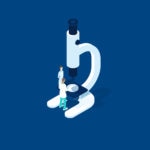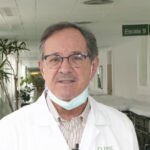Dr. Jordi Vila: "Massive testing would be ideal, but it’s impossible from a logistical standpoint"
Nearly two months after Spain declared a state of emergency due to the coronavirus crisis, the population has slowly begun to adapt to the lifting of some lockdown restrictions amid lots of questions and fear of a new outbreak. In an initiative promoted by the BBVA Foundation, Dr. Jordi Vila, the Head of Microbiology Services at the Hospital Clínic in Barcelona, gave a videoconference for BBVA employees to answer some of these questions. Among his responses regarding how to return to work in a safe manner, he indicated that “massive testing would be ideal, but it’s impossible from a logistical standpoint,” in his opinion.

The Professor of Microbiology at the University of Barcelona Medical School and Chair of the Spanish Society of Infectious Diseases and Clinical Microbiology (SEIMC) spoke of the relevance of massive testing, the validity of the different types of masks and possible new outbreaks of the virus, among other things.
Dr. Jordi Vila began by explaining the types of tests currently being administered, both to detect the virus and to find out whether someone has already had the disease, and therefore, has generated antibodies. “When we see a person that has an infection, the first thing we do is a medical diagnosis. We check to see if they have a fever, a cough, we see what symptoms they have,” explains the doctor. The next step is microbiological diagnosis using samples. “In the case of COVID-19, this sample is a nasopharyngeal swab (PCR), with which two types of microbiological diagnoses are possible: a direct diagnosis to try to detect the virus, and an indirect diagnosis where we look at the level of antibodies against the infection,” he adds. Indirect diagnosis uses a sample of the patient’s blood or serum.”
Vila explained the human body’s immune response to COVID-19: “When we start to have symptoms, we can find the virus in the nasopharyngeal swab. This virus multiplies in the cells of the nasopharynx and can reach levels of more than 100 million viral particles.” In the first few days after a person has been infected, they do not yet have antibodies. According to the doctor, antibodies appear around the fifth or sixth day and “increase progressively, reaching a peak after about 14-15 days, and then decline.”
“False negatives exist, especially with PCR, and this is most often due to taking the sample improperly,” says Vila. The test consists of introducing a swab in the nose to collect collect epithelial cells. “False negatives are often associated with erroneous sampling of that nasopharyngeal swab,” he explained.
The utility of massive testing
The Microbiology Professor spoke of the purpose of the test in the initial stage of the epidemic, when the goal was to actively find cases to try to control the spread of the virus. “Obviously massive testing would be ideal, but it’s impossible from a logistical standpoint,” affirms Vila. He therefore proposes selecting a portion of the population to take these tests, including healthcare workers, groups of older people and immunocompromised people or those with pathologies. In terms of the frequency of these tests in order to have conclusive results, the doctor recommends administering a second test ten days after the initial negative in order to continue monitoring the person.
Antibody detection tests deserve the same opinion: “At-risk populations should probably take this test.” In the case of companies, he feels that everyday work will depend more on the lifting of lockdown restrictions. “Clearly, it could be done, and it’s relatively easy from a microbiological diagnosis perspective in the laboratory, but we do not have tests for everyone [in Spain].”
Vila mentioned a recent study of 175 patients that have had COVID-19. This research concludes that approximately 70 percent of these patients have a high level of antibodies, which they developed as an immune response to the infection. 25 percent also have antibodies at a lower level, but with some defense against the infection. And no antibodies were detected in the remaining five percent, or they were detected at very low levels. “This five percent had an immune response other than producing antibodies. The immune response if very complex,” reports the doctor.
Therefore, it is important to know if a patient who has overcome the disease has developed this immune response. The same study determined that some antibodies were neutralizing, meaning that these people would be protected against a second infection.
Masks and possible repercussions of the virus
“It’s evident that we are facing a contagious virus, but not as much as it seems,” proclaims Vila. According to the doctor, its contagion ratio is between two and three (an infected person transmits the virus to an average of two or three people), while the measles has a ratio of 12-18.

Doctor Jordi Vila - Hospital Clínic de Barcelona
Now that we are closer to the end of the lockdown in Spain, lots of questions are emerging about the effectiveness of the protective systems. “Surgical masks prevent an infected person from transmitting the virus and provide some level of protection against acquiring it,” stresses Vila. These masks are made out of specific materials and have several layers of fabric; they are not comparable to cloth masks. “For immunocompromised individuals, masks called FFP2 are ideal as they prevent a person from spreading the virus and also prevent a person from acquiring it,” he says.
In terms of possible repercussions from the virus, the doctor is optimistic. So far the patients that have beaten SARS-CoV-2 do not have any. “For now, no consequences have been described. If the patient’s lungs are affected, for a certain amount of time their pulmonary function is impacted, but once the infection is gone, no impact has been described,” he says.
Will a vaccine be ready before the new outbreaks?
The virus’ behavior is still very unknown and controlling its spread now does not guarantee that there will not be new outbreaks. “Several circumstances could occur. The first is that, apparently, with rising temperatures and humidity we could reach very low transmission levels. But there could be a new outbreak in October or November,” the doctor emphasizes. What is certain is that containing it now would give us highly valuable time to be prepared for subsequent outbreaks: “It would give us some time to not only develop a vaccine for the fall, but also to find an antiviral and attack the new outbreak with more weapons.”
Since outbreaks seem inevitable, the search for the long-awaited vaccine is a priority. “There are currently 90 potential molecules or vaccines, at some stage of clinical trials,” Vila indicates. “This kind of vaccine trials uses a control group, which receives a placebo, and a vaccinated group. And they simply wait to see if members of each group acquire the infection spontaneously,” he explains. The duration of these kinds of tests varies considerably, and they are not conclusive until there is a sufficient number of positives in the group that did not receive the vaccine compared to the group that did.
Accelerating this process is no easy task and implies certain ethical risks. The doctor explained what is knowns as the ‘human challenge’, which entails infecting subjects with the virus, a procedure that has been used in cases like malaria. The main problem is that there is currently no treatment for the disease.” “We do not currently have a treatment for COVID that would allow us to use this option of infecting healthy volunteers, so there is an ethical component that would have to be analyzed in detail,” he adds.
Before all of this is over, there are certain positive aspects that this exceptional situation has brought us. “We are acquiring a series of habits that will help us significantly in many aspects, especially in the infectious disease field,” explains Vila. Lessons learned and habits we have been forced to adopt, such as frequently washing hands, which will help us to not only stop new viruses, but also stop the transmission of bacteria and other types of microorganisms.